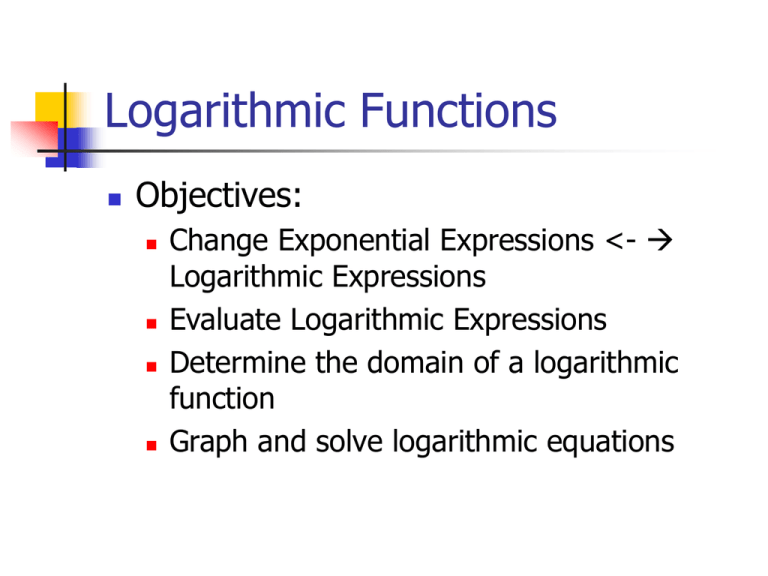Logarithmic Functions: Equations, Graphs & Applications
advertisement

Logarithmic Functions Objectives: Change Exponential Expressions <- Logarithmic Expressions Evaluate Logarithmic Expressions Determine the domain of a logarithmic function Graph and solve logarithmic equations Logarithmic Functions Inverse of Exponential functions: If ax = y, then logay = x Domain: 0 < x < infinity Range: neg. infinity < y < infinity Translate each of the following to logarithmic form. 23 = 8 41/2 = 2 Find the domain of: F(x) = log2(x – 5) G(x) = log5((1+x)/(1-x)) To graph logarithmic functions Graph the related exponential function. Reflect this graph across the y=x line (Switch the x’s and y’s) Graph: y = log1/3x Natural logarithms and Common Logarithms Natural Logarithm (ln) : loge Common Logarithm (log): log10 Graph y=ln x (Reflect the graph of y=ex) Graph y = -ln (x + 2), Determine the domain, range, and vertical asymptote. Describe the translations. Graph: f(x) = log x (Reflect the graph of y = 10x) Graph: f(x) = 3 log (x – 1). Determine the domain, range, and vertical asymptote. Describe the translations on the graph Solving Logarithmic Equations Logarithm on one side: Write equation in exponential form and solve Examples: Solve: log3(4x – 7) = 2 Solve: log2(2x + 1) = 3 Example The atmospheric pressure ‘p’ on a balloon or an aircraft decreases with increasing height. This pressure, measured in millimeters of mercury, is related to the height ‘h’ (in kilometers) above sea level by the formula p=760e-0.145h Find the height of an aircraft if the atmospheric pressure is 320 millimeters of mercury. Example 2 The loudness L(x), measure in decibels, of a sound of intensity x, measure in watts per square meter, is defined as L(x)=10log(x/Io) where Io = 10-12 watt per square meter is the least intense sound that a human ear can detect. Determine the loudness, in decibels, of heavy city traffic: intensity of x=10-3 watt per square meter. Example 3 Richter Scale: M(x) = log (x/xo) where x0=10-3 is the reading of a zero-level earthquake the same distance from its epicenter. Determine the magnitude of the Mexico City earthquake in 1985: seismographic reading of 125,892 millimeters 100 kilometers from the center. Properties of Logarithms Loga1 = 0 Logaa = 1 alogaM = M Logaar = r Loga(MN) = logaM + logaN Loga(M/N) = logaM – logaN LogaMr = r logaM Look at Examples Page 444-445 Other examples: Page 449: #8, 12, 16, 20, 24, 28, 32, 36, 44, 52, 60 Change of Base Formula: logaM= logbM / logba Example: log589 Example: log632 Page 449: #65, 71, 74 Solving logarithmic equations With logarithms on both sides. Combine each side to one logarithm Cancel the logarithms out Solve the remaining equation Examples: Page 450: #81, 87 Logarithm on One side of Equation Combine terms into one logarithm Write in exponential form Solve equation that will form Ex: Page 454 #33, 37 Solving Exponential Equations Variable is in the exponent. Use logarithms to bring exponent down and solve. Solve: 4x – 2x – 12 = 0 Solve: 2x = 5 Solve: 5x-2 = 33x+2 log3x + log38 = -2 8 .3 x = 5 log3x + log4x = 4 Applications Simple Interest: I = Prt Interest = Principal X Rate X time Compount Interest: A = P . (1 + r/n)nt Time is in years Annually: once a year Semiannually: Twice per year Quarterly: Four times per year Monthly: 12 times per year Daily: 365 times per year Compound Continuously Interest rt A = Pe The present value P of A dollars to be received after ‘t’ years, assuming a per annum interest rate ‘r’ compounded ‘n’ times per year, is P=A.(1 + r/n)-nt Finding Effective Rate of Interest On January 2, 2004, $2000 is placed in an Individual Retirement Account (IRA) that will pay interest of 10% per annum compounded continuously. What will the IRA be worth on January 1, 2024? What is the effective rate of interest? Present Value Formula for compounded continuously interest P = A( 1 + r/n)-nt P = Ae-rt Examples: Page 462 #5, 11, 15, 21 Exponential Decay P = Ae-rt Page 472 #3 Other Applications A(t) = Aoekt : Exponential Growth Newton’s Law of Cooling: U(t) = T + (uo – T)ekt, k < 0 Logistic Growth Model: P(t) = c / (1 + ae-bt) c: carrying capacity Examples Page 472: #1, 13, 22 Assignment Page 454, 462, 472 Exponential and Logarithmic Regressions Input data into calculator Go to calculate mode Find ExpReg (Exponential Regression) y = abx Find LnReg (natural logarithm regression) y = a + b.lnx Logistic Regression y=c/(1+ae-bx) Examples Page 479: #1, 3, 7, 11 1. c. d. e. f. b. EXP REG: y = .0903(1.3384)x y=..0903(eln(1.3384))x Graph: y = .0903e.2915x n(7) = .0903e(.2915 x 7) .0903e(.2915(t)) = .75 3. b. EXP REG: y = 100.3263(.8769)x c. 100.3263(eln.8769)x d. Graph: y = 100.3263e(-.1314)x e. 100.3263e(-.1314)x = .5 (100.3263) f. 100.3263e(.1314)(50) = .141 g. 100.3263e(-.1314)x = 20 7. b. LnReg: y = 32741.02 – 6070.96lnx c. Graph d. 1650 = 32741.02 – 6070.96 lnx = 168 computers 11. b. LOGISTIC REG (not all calculators have): Y = 14471245.24 / (1 + 2.01527e-.2458x) c. d. Graph Y = 14,471,245.24 / (1 + 2.01527e-.2458x) Y = 14,471,245.24 / (1 + 0) e. 12.750,854 = 14,471,245.24 / (1 + 2.01527e-.2458x) Assignment Pages: 472, 479






